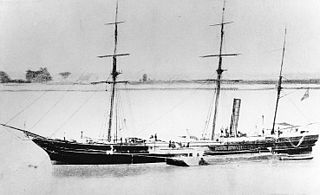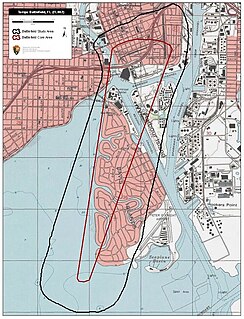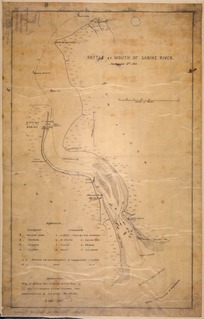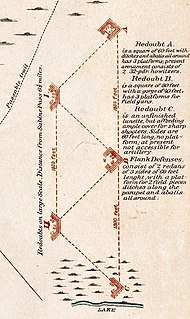
Harrisonburg is a village in and the parish seat of Catahoula Parish, Louisiana, United States. The population was 348 as of the 2010 census, down from 746 in 2000.

The flags of the Confederate States of America have a history of three successive designs during the American Civil War. The flags were known as the "Stars and Bars", used from 1861 to 1863; the "Stainless Banner", used from 1863 to 1865; and the "Blood-Stained Banner", used in 1865 shortly before the Confederacy's dissolution. A rejected national flag design was also used as a battle flag by the Confederate Army and featured in the "Stainless Banner" and "Blood-Stained Banner" designs. Although this design was never a national flag, it is the most commonly recognized symbol of the Confederacy.

CSS McRae was a Confederate gunboat that saw service during the American Civil War. Displacing around 680 tons, she was armed with one 9-inch (229 mm) smoothbore and six 32-pounder (15 kg) smoothbore cannon.
The first USS Arizona was an iron-hulled, side-wheel merchant steamship. Seized by the Confederate States of America in 1862 during the American Civil War, she was captured later the same year by the United States Navy.

The Battle of Tampa, also known as the "Yankee Outrage at Tampa", was a minor engagement of the American Civil War fought June 30 – July 1, 1862, between the United States Navy and a Confederate artillery company charged with "protecting" the village of Tampa, Florida. Though small, Tampa's port was a key hub of trade for Central Florida, and several blockade runners from Tampa regularly slipped past the Union naval blockade that extended down the Atlantic coast around to Florida's west coast.

The Second Battle of Sabine Pass was a failed Union Army attempt to invade the Confederate state of Texas during the American Civil War. The Union Navy supported the effort and lost three gunboats during the battle, two captured and one destroyed.

CSS Manassas, formerly the steam icebreaker Enoch Train, was built in 1855 by James O. Curtis as a twin-screw towboat at Medford, Massachusetts. A New Orleans commission merchant, Captain John A. Stevenson, acquired her for use as a privateer after she was captured by another privateer CSS Ivy. Her fitting out as Manassas was completed at Algiers, Louisiana; her conversion to a ram of a radically modern design made her the first ironclad ship built for the Confederacy.

The Bermuda Hundred campaign was a series of battles fought at the town of Bermuda Hundred, outside Richmond, Virginia, during May 1864 in the American Civil War. Union Maj. Gen. Benjamin Butler, commanding the Army of the James, threatened Richmond from the east but was stopped by forces under Confederate Gen. P.G.T. Beauregard.

CSSResolute was a tugboat built in 1858 at Savannah Georgia as the Ajax which served in the Confederate States Navy during the American Civil War.
CSS Savannah, later called Old Savannah and Oconee, was a gunboat in the Confederate States Navy during the American Civil War.

The siege of Fort Pulaski concluded with the Battle of Fort Pulaski fought April 10–11, 1862, during the American Civil War. Union forces on Tybee Island and naval operations conducted a 112-day siege, then captured the Confederate-held Fort Pulaski after a 30-hour bombardment. The siege and battle are important for innovative use of rifled guns which made existing coastal defenses obsolete. The Union initiated large-scale amphibious operations under fire.

Laurent Millaudon was a wooden side-wheel river steamboat launched at Cincinnati, Ohio, in 1856 operating in the New Orleans, Louisiana, area, and captained by W. S. Whann. At the beginning of the American Civil War she was taken into service by the Confederate Navy as CSS General Sterling Price. On 6 June 1862, she was sunk at the Battle of Memphis. She was raised and repaired by the Union army, and on 16 June 1862 was moved into Union service as USS General Price and served until the end of the war.

The Battle of Forts Jackson and St. Philip was the decisive battle for possession of New Orleans in the American Civil War. The two Confederate forts on the Mississippi River south of the city were attacked by a Union Navy fleet. As long as the forts could keep the Federal forces from moving on the city, it was safe, but if they were negated, there were no fall-back positions to impede the Union advance.

The Battle of Galveston Harbor was fought at Galveston, Texas on October 4, 1862, during the American Civil War. After attempts to blockade the Texas coastline were unsuccessful, the Union Navy decided to attempt to capture the port of Galveston. While Galveston was defended by Confederate forces, most of the cannons in the city's defenses were removed, as Galveston was thought to be indefensible. On October 4, five Union naval vessels commanded by Commander William B. Renshaw approached Galveston, and a single ship, USRC Harriet Lane was sent into Galveston Bay under a flag of truce.

USS Fort Hindman was a steamer acquired by the Union Navy during the American Civil War. She was placed in service and used by the Navy to patrol navigable waterways of the Confederacy to prevent the South from trading with other countries.

Fort Manhassett was a group of earthen fortifications that guarded the western approaches to Sabine City, Texas during the American Civil War, operating in service of the Confederate Army from October 1863 to May 1865.

USS Conestoga was originally a civilian side-wheel towboat built at Brownsville, Pennsylvania, in 1859. She was acquired by the U.S. Army in June 1861 and converted to a 572-ton "timberclad" river gunboat for use by the Western Gunboat Flotilla, with officers provided by the navy.

Brigadier-General Samuel Wragg Ferguson was a senior officer of the Confederate States Army who commanded cavalry in the Western Theater of the American Civil War. After the civil war, Ferguson served as a member of the Mississippi River Commission.

The Chalmette Regiment, Louisiana State Militia (CSA) was a Louisiana militia regiment that consisted of foreign volunteers. The Regiment was called into Confederate service for 90 days March 1, 1862. Mustered out in May 1862, the regiment was again called into service in May 1863 to defend Fort Beauregard.
CSS Pontchartrain was a gunboat that served in the Confederate States Navy during the American Civil War. Built in 1859 for passenger and cotton trade, she was purchased by the Confederates in October 1862. After seeing action against Union land positions during the campaigns for New Madrid, Missouri, and Island Number Ten, she was transferred to serve on the Arkansas River and the White River. In June 1862, two of her cannons were taken to a land fortification at St. Charles, Arkansas, where part of her crew saw action in the Battle of St. Charles while manning the guns. Her other cannons were then offloaded at Fort Hindman, where more of her crew were captured while fighting on land at the Battle of Arkansas Post in January 1863. Pontchartrain herself remained inactive at Little Rock, Arkansas, and was burned to prevent capture in September 1863 when the Confederates abandoned the city.

















